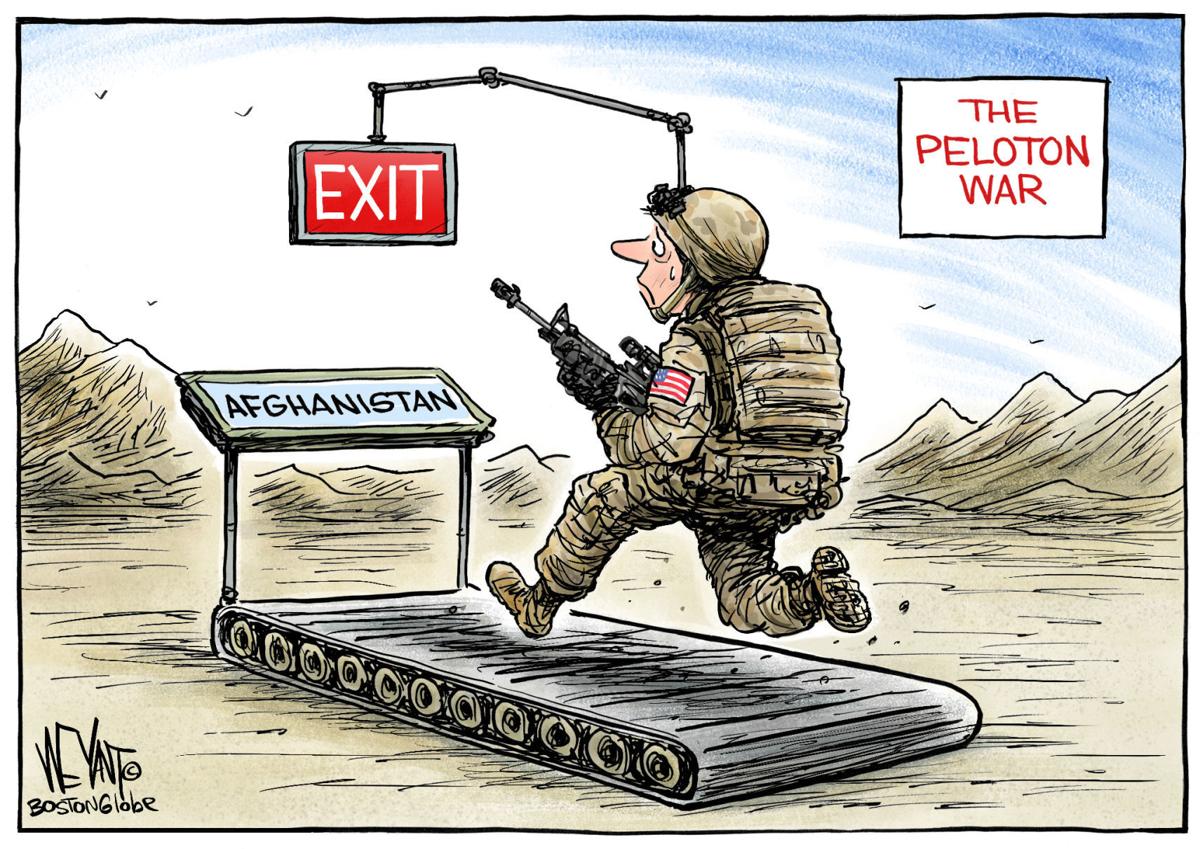
“The war is not meant to be won, it is meant to be continuous…The war is waged by the ruling group against its own subjects and its object is not the victory over either Eurasia or East Asia, but to keep the very structure of society intact.”
George Orwell in Nineteen Eighty-Four.
George Orwell was right. Orwell’s insight applies to the militaristic foreign (and domestic with respect to the American Indians) policy of the United States from its inception. How does war, to use Orwell’s words, “keep the very structure of society intact”?
The answer to this question starts with observing that “the very structure” of the society created in North America by British and other European colonists was, in contrast to American Indian social structure, a structure of class inequality, in which some haves were wealthy and powerful; and these haves dominated and oppressed the much larger number of have-nots to enrich themselves. The have-nots were never happy campers, and resisted their domination and oppression by the haves in many different ways, to be examined below.
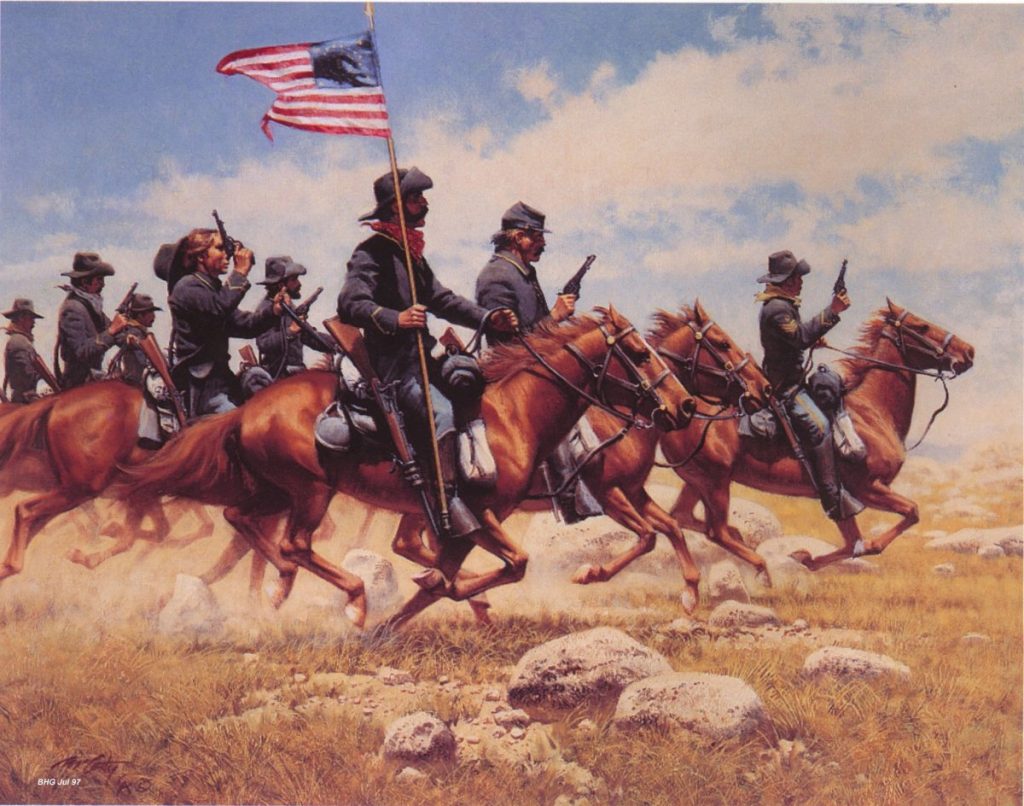
One of the most effective means by which the class of haves made (and still makes) the have-nots submit to it is by ensuring the existence of a bogeyman enemy (either finding a handy already-existing one or, if necessary, inventing one) so frightening to the have-nots that the haves, by pretending to protect the have-nots from the bogeyman enemy, can make the have-nots obey them despite the very real grievances the have-nots hold against the haves.
As the title of this article emphasizes, it is the upper ruling class as a whole, not just the part of it that profits from war—the military-industrial complex—that needs to keep the United States at war.
The Americans currently in charge of keeping the United States at war against an enemy are the neo-conservatives—ultra-nationalists promoting a muscular conservatism (breaking from the Republican Party’s historic isolationism during the 1920s).
One of the leading neo-conservative think tanks is the Center for Strategic and International Studies (CSIS). It sponsors each year a “Zbigniew Brzezinski Annual Prize and Lecture.” This website lists CSIS as “One of the top ten think tanks in the world” and says that it “often exerted direct influence on the White House with respect to foreign policy and defense issues.” The website identifies “notable CSIS-associated people” as including former U.S. Secretary of State Madeleine Albright; former Israeli President Ehud Barak; current U.S. Secretary of State Antony Blinken; former U.S. Secretary of State Henry Kissinger; former U.S. Senator Sam Nunn; and Pritzker Organization CEO Thomas J. Pritzker.
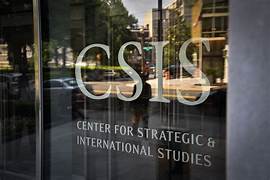
Who funds CSIS? Is it only funded by the obvious culprits, the arms manufacturers such as Lockheed Martin and Raytheon? No. It gets funding from a much wider spectrum of Big Money in the United States. According to CSIS’s own website, its corporate funders are listed here, and its foundation funders are listed here (and it also has government funders, of course, listed here).
Some of the corporate funders include Bank of America, Chevron, ExxonMobil, Facebook, JPMorgan Chase, Johnson & Johnson, McAfee, Merck, Microsoft, Oracle, Apple, Canon, General Electric, IBM, Procter & Gamble, Sun Life Financial, United Airlines, Verizon, American Airlines, Disney, Google and Kellogg’s.
Not exactly exclusively arms manufacturers, right?
What about CSIS’s foundation donors? The list includes the Bill and Melinda Gates Foundation, the Robert Wood Johnson Foundation, the Carnegie Corporation of New York, the Rockefeller Brothers Fund and the World Wildlife Fund.
The point is that warmongering against bogeyman enemies is not something that only arms manufacturers want; it is something that the billionaire class in general wants. This ruling billionaire class needs the U.S. to be at war against a bogeyman enemy in order to have any half-way credible argument to persuade the have-not Americans to put up with its obscene wealth, power and privilege and, on top of that, treatment of the have-nots like dirt.
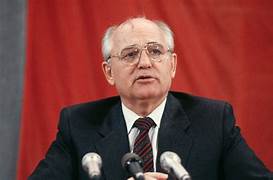
There is actually even a downside to winning a war: It means one no longer has the frightening bogeyman enemy to use to control one’s own have-nots. When Mikhail Gorbachev ended the Soviet Union, he told American diplomats, “I will do something very terrible to you America—I am going to take away your enemy.” [Source: here and an equivalent one here]
Unless you understand the need that oppressive ruling classes have for a bogeyman enemy, you would not understand Gorbachev’s remark. George Orwell, however, understood this point perfectly, which is why he wrote:
“The war is not meant to be won, it is meant to be continuous…The war is waged by the ruling group against its own subjects and its object is not the victory over either Eurasia or East Asia, but to keep the very structure of society intact.” —George Orwell in Nineteen Eighty-Four.

A BRIEF HISTORY OF THE U.S. RULING CLASS USING BOGEYMAN ENEMIES TO CONTROL ITS HAVE-NOTS
Waging War Against the American Indian Bogeyman
When Europeans arrived on the shores of the North American continent, they arrived as a class society, with a few rich and powerful European haves (the ruling class) oppressing the great many European have-nots on the new American land. This point is hardly ever mentioned in the standard discourse, which speaks only of “the Europeans” as if there were no fundamental difference between the haves and have-nots. But there was a fundamental difference.
For one example of this factually wrong standard discourse, and my refutation of it, please see my article about the Mayflower Plymouth Colony here.
Likewise, the standard discourse about our Founding Fathers is a complete cover-up of the truth about how they were the haves oppressing the have-nots back then. Read about this here.
As the Europeans began settling in North America, they of course encountered American Indians who lived there. What happened?
One thing that happened is that a substantial number of European have-nots opted to “go native.”
Ward Churchill wrote about this:
“Probably the earliest group of English to have simply melted into a native society were the inhabitants of Raleigh’s ‘lost colony’ of Roanoak in 1590. A century later, there were literally thousands of ‘white Indians’—mostly English and French, but Swedes, Scots, Irish, Dutch and others as well—who, displeased with aspects of their own cultures, had either married into, been adopted by, or petitioned for naturalization as member/citizens of indigenous nations. By then, the phenomenon had become pronounced enough that it had long-since precipitated a crisis among the Puritans of Plymouth Colony and figured in their waging of a war of extermination against the Pequots in 1637.
“The attraction of ‘going native’ remained so strong, and the willingness of indigenous peoples to accept Europeans into their societies so apparent, that it prevailed even among those captured in Indian/white warfare. During the 1770s, George Croghan and Guy Johnson, both acknowledged authorities on the native peoples of the mid-Atlantic region, estimated that the great bulk of the several hundred English prisoners of all ages and both genders taken by the Indians had been adopted by them rather than being put to death.
“The literature of the period is literally filled with observations. Virginia’s Lieutenant Governor Francis Fauquier, for example, noted that whites ‘recovered’ from Indians had to be ‘closely watched [lest] they will certainly return to the Barbarians.’ Colonel Henry Bouquet, who headed a 1764 expedition to take charge of ‘captives’ returned under terms of a treaty with England by the Shawnees, Miamis and other peoples of the Ohio River Valley, issued orders that ‘they are to be closely watched and well Secured [as] most of them, particularly those who have been a long time among the Indians, will take the first Opportunity to run away.’ The Reverend William Smith, chaplain and chronicler of Bouquet’s foray, noted that most younger whites seemed to view their ‘liberators’ as captors and ‘parted from the savages with tears.’”[1]
One particularly good book about this is the exceedingly well-researched and well-written book, The Unredeemed Captive: A Family Story from Early America, by John Demos. This book describes how, in 1704, Mohawks and French forces captured some English Puritans from Deerfield, Massachusetts.

Over the years following this there were negotiations leading to the return of most of the prisoners. But Eunice, the daughter of a Puritan minister who had been captured and later released, refused to return, married a Mohawk man and made several trips from her Mohawk home in Canada to visit her Puritan relatives for weeks at at time in Deerfield. But Eunice always returned to her Mohawk society despite the strong efforts of her father to persuade her to stay. Read here about another similar story.
European colonist rulers, in contrast, viewed American Indians as sub-human (regarding their rights if not their intelligence), and they waged an ethnic-cleansing war against them. This war at times entailed the goal of physically exterminating (killing) the Indians and at other times the goal of destroying their civilizations, either by destroying their farming civilizations or by destroying their nomadic civilizations based on hunting buffalo, and enclosing them in tiny reservations where they would no longer be an obstacle to European domination of North America “from sea to shining sea.”
A good book about the latter goal of ethnic cleansing, focused on the Great Plains Comanche Indians is Empire of the Summer Moon by S.C. Gwynne. The book tells the story of one of the Comanche great chiefs, Quanah Parker, the son of Cynthia Ann Parker who was a European captured by the Comanches as a nine-year-old girl assimilated into the tribe (who, when “rescued,” kept trying to return to the Comanches).
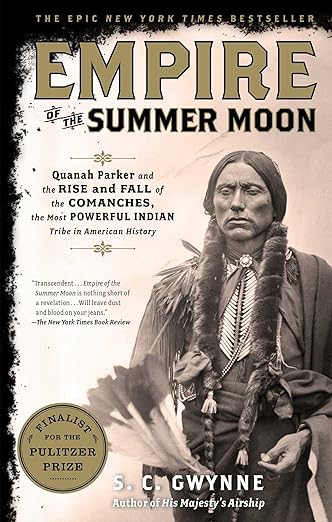
It is important to know that the particular European colonists who initiated the ethnic cleansing of American Indians, who created the famous “Manifest Destiny” notion that exclusively European domination of North America from “sea to shining sea” was God’s will, and who encouraged and when necessary ordered European have-nots to carry out the violent ethnic cleansing, were also the oppressors of ordinary European colonists and, of course, Black people; they were the slave-owners whom most Southern whites at the time of the Civil War (the period when the ethnic cleansing of the Great Plains Indians was in full swing) hated (yes, hated!) as a class that oppressed them as well as the slaves, as one can read about in detail here.
European ethnic-cleansing violence naturally elicited, in return, Indian violence against European settlers encroaching on their land. The violence on both sides was absolutely brutal: killing and raping and torturing and scalping and so on. It was violence designed to make the enemy leave.
Naturally, when European have-nots were attacked by Indians they tended to rally around their rulers in defense against the Indians. The European rulers gained the obedience of the European have-nots this way. For the European rulers, the Indians made a perfect bogeyman enemy with which to control the European have-nots. Because of this usefulness of the Indians as a bogeymen enemy, the European rulers had a strong motive not to allow peace to break out between Europeans and Indians because that would have rendered the bogeyman enemy no longer frightening enough to drive the European have-nots into obedience to their European rulers.
This is why the European rulers avoided creating peaceful and mutually respectful relations with the American Indians. It did not suit their oppressive (oppressive of the European have-nots, that is) purpose to do so. European rulers were an upper class that valued personal self-interest—greed—and that created a religion to justify not only oppressing European have-nots and African Blacks but also stealing land and wealth from American Indians and killing them to get it.
If the have-nots had succeeded in removing the haves from power, they, along with the American Indians, would most likely have made North America something entirely different from the United States of America that it is today, something with a social structure very different from the class inequality structure that the haves kept intact by waging a war against a bogeyman enemy.
The haves of North America have been using bogeyman enemies to preserve the structure of society by being at war ever since. This is their #1 priority: more important than winning the war is being at war. If peace breaks out, the haves know they are at high risk of losing control over their have-nots and being removed from power. If this ever happened, they would no longer be able to enjoy whatever material gains they might have hoped to gain by winning a war. Thus, it is better for the haves to be at war and not win it than to win a war and let peace break out.
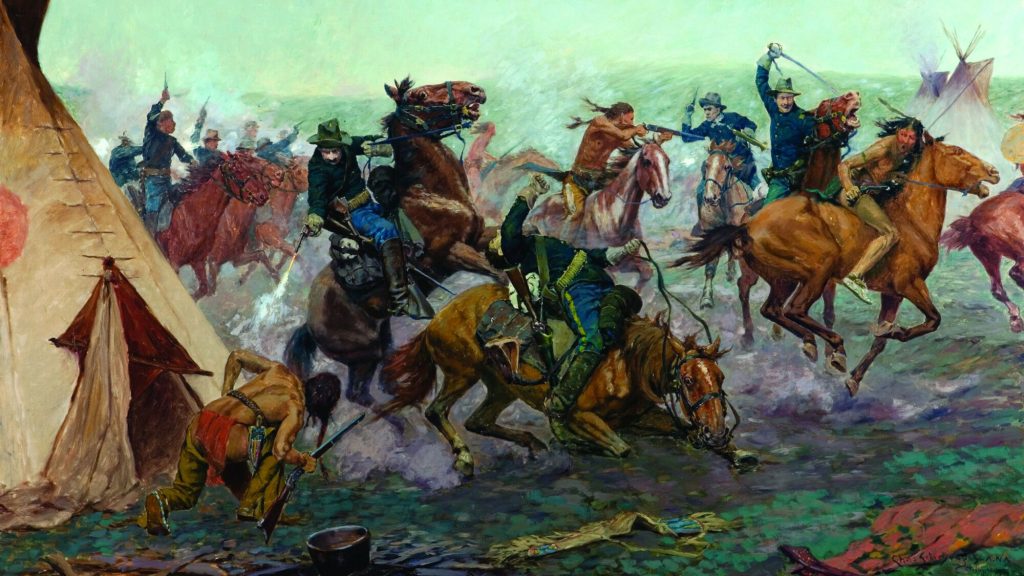
The Spanish-American War (April 21, 1898 – December 10, 1898) and the Philippine-American War (February 1899 – July 1902)
“You furnish the pictures, and I’ll furnish the war.” —Attributed to William Randolph Hearst.[2]
“The McKinley administration wanted war to divert attention from the existing economic situation, as the promised ‘good times,’ he claimed, had failed to materialize.”[3]
See further discussion of the Spanish-American War in Supplementary Material: The Spanish-American War.
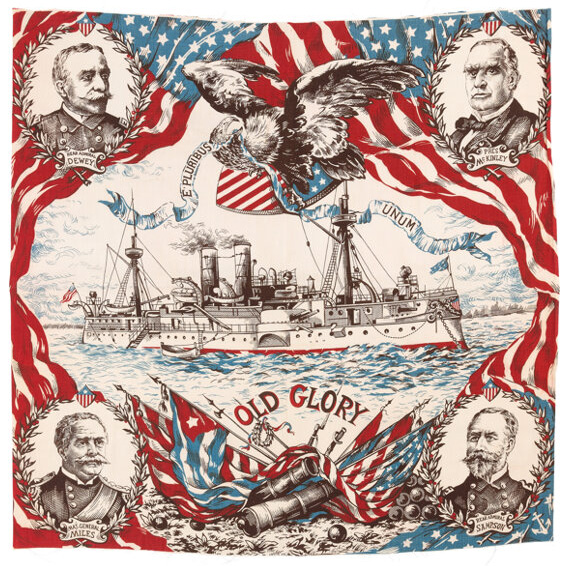
World War I
In The Great Class War 1914-1918 about World War I, historian Jacques R. Pauwels makes the case that, quoting the book description at the back of the book and online:
“For European statesmen, a large-scale war could give their countries new colonial territories, important to growing capitalist economies. For the wealthy and ruling classes, war served as an antidote to social revolution, encouraging workers to exchange socialism’s focus on international solidarity for nationalism’s intense militarism. And for the working classes themselves, war provided an outlet for years of systemic militarization—quite simply, they were hardwired to pick up arms, and to do so eagerly.” [Emphasis added.] [For further discussion of World War I see Supplementary Material: World War I]
World War II
In the 1930s during the Great Depression the rulers of the United States, Germany and Japan all faced increasingly revolutionary working-class uprisings and feared actual revolutions. In order to control their own people, the rulers of these nations instigated World War II, so they could persuasively order their own people to stop waging the class war and instead join their rulers in waging war against other nations. I discuss this in detail in my book, The People As Enemy: The Leaders’ Hidden Agenda in World War II, much of which is online here.
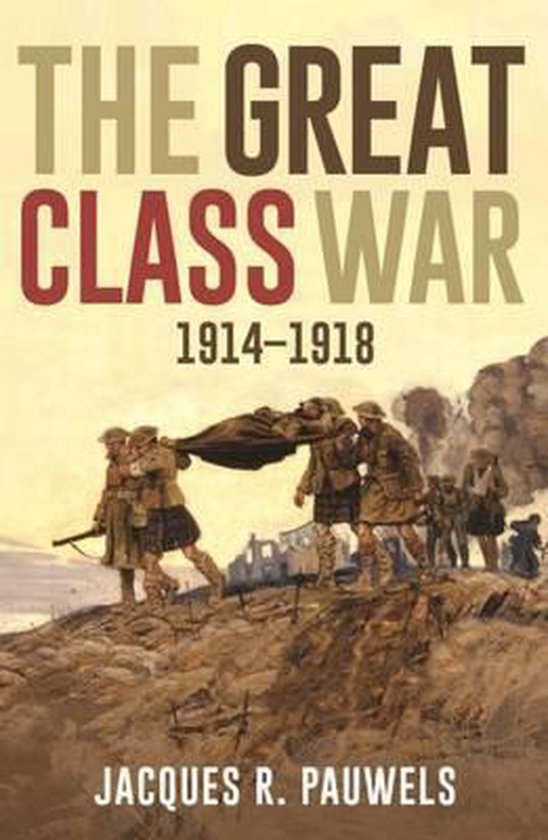
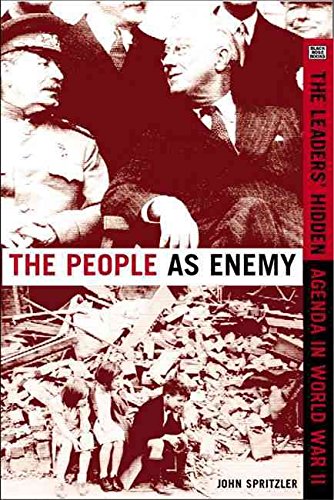
In the U.S. during the years prior to its entry into World War II, the American ruling class feared the increasingly revolutionary American working class, and had to figure out some way to forestall revolution. What was going on at this time is illustrated by the examples of sharp class conflict given below:
When a longshoremen’s strike in 1934 led to a general strike in San Francisco of 130,000 workers, which spread to Oakland and then up the Pacific Coast, the Los Angeles Times wrote: “The situation in San Francisco is not correctly described by the phrase ‘general strike.’ What is actually in progress there is an insurrection, a Communist-inspired and led revolt against organized government. There is but one thing to be done but put down the revolt with any force necessary.” FDR’s National Recovery Administration chief, General Hugh S. Johnson, went to San Francisco and declared the general strike a “menace to the government” and a “civil war.”[4]

In the same year 325,000 textile workers, many of them women, used “flying squadrons” to spread their strike throughout the South from mill to mill, often battling guards, entering the mills, unbelting machinery and fighting non-strikers.
So alarmed was The New York Times that it warned, “The grave danger of the situation is that it will get completely out of the hands of the leaders…The growing mass character of the picketing operations is rapidly assuming the appearance of military efficiency and precision and is something entirely new in the history of American labor struggles. Observers…declared that if the mass drive continued to gain momentum at the speed at which it was moving today, it will be well nigh impossible to stop it without a similarly organized opposition with all the implications such an attempt would entail.”[5]
Declaring martial law, South Carolina’s governor said that a “state of insurrection” existed. When the strike spread to New England, Governor Theodore Green, of Rhode Island, declared that “there is a Communist uprising and not a textile strike in Rhode Island,” and then declared a state of insurrection.[6]
Georgia Governor Eugene Talmadge declared martial law. National Guardsmen began mass arrests of flying squadrons and held them without charge in a concentration camp where Germans had been held during World War I. “By September 19 the death toll in the South had reached thirteen.”[7]
Events like these (read about them in greater detail here) hit all parts of the nation, and this was just the warm-up to the wave of sit-down strikes in 1936-37 during which 10,000 workers occupied GM’s Flint, Michigan, plant with help from thousands of workers who traveled hundreds of miles to join them.
Following that strike, Chrysler faced 6,000 sit-downers with 50,000 picketers outside its plants and The New York Times felt obliged to warn business and government leaders: “It is generally feared that an attempt to evict the strikers with special deputies would lead to an inevitable large amount of bloodshed and the state of armed insurrection.”[8]

Big business was even afraid that the electoral system, which was supposed to ensure that Americans would forsake mass direct action for reliance on tame and trusted politicians, was about to fail in this purpose. Louisiana’s governor, Huey Long, had seven million followers who wanted a dramatic redistribution of wealth and viewed FDR as an obstacle.
Most alarmingly, the Democratic Party in California was captured in 1934 by a radical mass movement which wanted the state to seize land and factories so that unemployed people could operate them in a moneyless network of production for need, not profit.
Their leader, Upton Sinclair, a long-time socialist, swept away his opponents and won the Democratic Party primary, making him its candidate for governor. He was only defeated in the gubernatorial election by an unprecedented smear campaign launched jointly by liberal and conservative California newspapers. But the handwriting was on the wall.
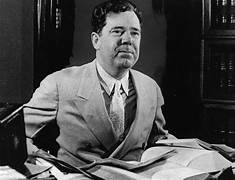
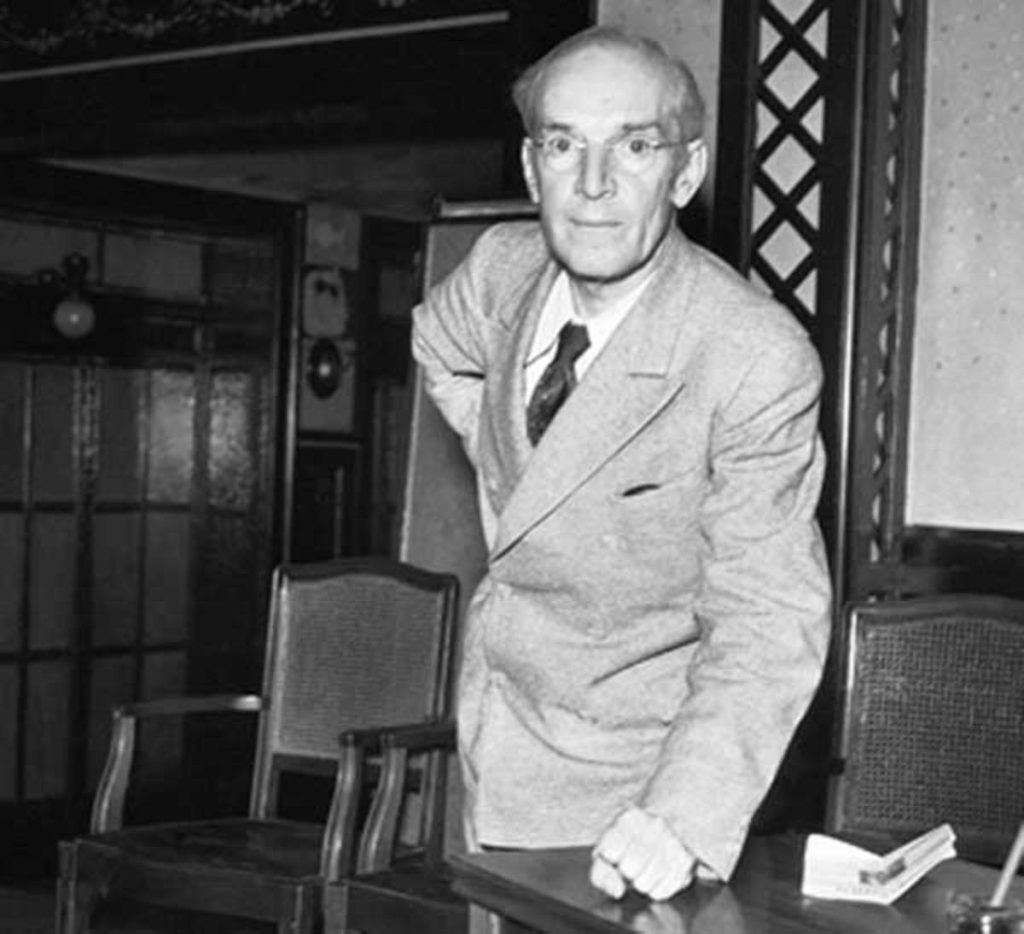
FDR tried to control the rebellion with New Deal promises. But it did not work. His famous Wagner Act of 1935, for example, tried to pacify workers by making unions legal. The Act also locked unions into an elaborate system of government regulations designed to ensure that conservative labor leaders would be able to control their unruly rank-and-file. But workers developed the sit-down tactic in the next two years precisely to keep control in their own hands.
War Is the Solution to the Threat of Revolution
Ruling elites have known for centuries that when revolution threatens at home, desperate measures are required, and the most effective one is to go to war. For example, in 1904, on the eve of the Russo-Japanese War, the Russian Czar’s interior minister, Vyacheslav Plehve, declared, “What this country needs is a short victorious war to stem the tide of revolution.”[9]
This is the only way to understand the little-known truth about how FDR’s advisers reacted to the news of the Japanese attack on Pearl Harbor. Secretary of War Stimson’s diary entry at 2:00 p.m. on December 7, written after learning from the President about the attack on Pearl Harbor, reads:
“Now the Japs have solved the whole thing by attacking us directly in Hawaii…My first feeling was of relief that the indecision was over and that a crisis had come in a way which would unite all our people.”[10]
Not shock, but relief. Relief that war would finally force American workers to unite with, instead of rebel against, America’s rulers.
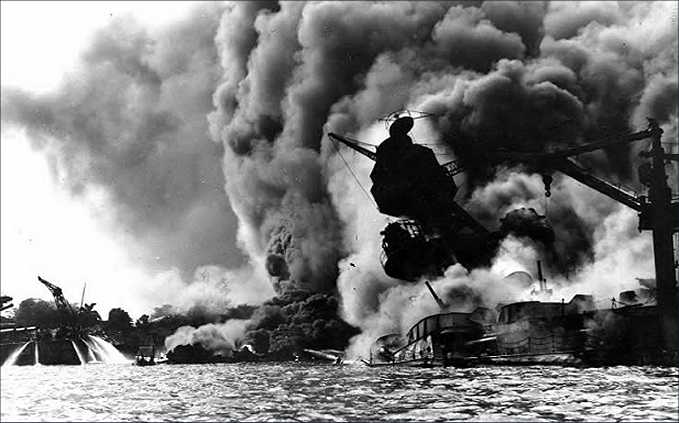
FDR waged the war in a manner designed to prolong it rather than to defeat the fascists quickly; and he attacked working class pro-democracy forces abroad that were fighting the fascists. To read excerpts from my same book on WWII about how FDR did this in both the Pacific theater of war and the European theater of war, see Supplementary Material: World War II.
The Cold War Against the Soviet Union
The American ruling class was highly fearful after the 1917 bolshevik revolution that this workers-led revolution which promoted the nationalization of industry could spread to Western Europe and the United States. The Wilson administration responded by invading Russia with six other nations and rounding up dissenting groups in the U.S. under the first red scare.
At the end of World War II, needing another foreign enemy with the demise of the Axis Powers, the CIA spread propaganda suggesting that the Soviet Union was intent on conquering the rest of Europe even though it was in no position to do so having suffered a record 25 million+ casualties in World War II.
U.S. leaders for decades subsequrntly invoked the Soviet bogeyman in justifying massive defense spending, covert interference in foreign nations in service of U.S. imperialism and domestic attacks on organized labor whose leaders were accused of being communists
Here and here are two articles about how the U.S. public during the Cold War was made to fear a “missile gap” (i.e., Soviet superiority to the U.S. in number of nuclear missiles) when in fact no such missile gap actually existed.

The American ruling class generally wanted a credible foreign enemy with which to control the American people. Such an enemy enabled the rich upper class rulers to pose as the protectors of the nation from the Evil Empire, and in this way make Americans tolerate unjust domination by this upper class, including allowing it to make huge profits from the weapons industry by bilking American taxpayers. (Soviet rulers likewise needed the American bogeyman enemy to control their own people.) Waging the Cold War as an Orwellian war of social control cost many ordinary people their lives and kept most people in great fear, but it was wonderful for the ruling elites.
The Vietnam War
The real aim of the war cannot be understood as “to defeat the Communists.” The aim was not to win the war but rather to be at war. But only very few people at the top of the American power hierarchy would know this—they simply were not told. The generals and most government officials would believe it was a real war, waged to be won.

Of course, some generals knew it could not be won, but needed to be waged anyway because that is what the President insisted upon; this is what the Pentagon Papers revealed to be the case. NPR reports that, according to historian Douglas Brinkley, Secretary of Defense Robert McNamara “knew in 1965 that Vietnam was not winnable, and didn’t tell the president.”
It is possible that U.S. rulers expected that the Vietnam War would, just like the Korean War and World Wars I and II before it, unite Americans behind their rulers and make them accept their oppression by those same rulers. It is possible U.S. rulers were shocked that, for some reason they never anticipated, Americans rose up against the Vietnam war.
When this happened, the rulers could hardly announce, “OK, we’ll end the war, since we never aimed to win it in the first place.” So the war dragged on, leading to more anti-government rebellion in the U.S. than anybody could have predicted. But the purpose of the war was the same as the purpose of the earlier wars, to control the have-nots. It just didn’t work this time.
The War on Terror Following 9/11
The Soviet Union officially ended on December 25, 1991, leaving the United States—to its alarm!—(as Gorbachev remarked at the time, mentioned above) without a credible enemy. For several years the best enemies that the United States rulers could find were defeated too easily to play the role the Soviet Union had played. Saddam Hussein was defeated by George H.W. Bush quickly with only 80 American battle deaths, North Korea was seen to be a basket case, Grenada hardly counted as a seriously frightening bogeyman enemy.
Something had to be done because American have-nots along with the have-nots of the world were rising up against the haves. The anti-globalization movement had become world-wide and huge, and also increasingly explicitly opposed to capitalism. The U.S. needed a new Cold War, but against whom?
U.S. rulers chose Islamic Fundamentalists for the job. This required inventing the enemy, a process that Dave Stratman describes in detail in his “Inventing the Enemy.” President Obama did his share of the heavy lifting as I describe in my “Drones Create Hatred of the U.S., Which Is Their Real Purpose.”
September 11th put the kibosh on the anti-globalization movement and most anti-establishment efforts in the United States for several years. People were told, and naturally felt, that it was a time to “rally ’round the flag,” not wage a struggle against one’s government that purported to be protecting its people from “the terrorists.”
War Against Russia in Ukraine
U.S. actions prior to Russia’s Special Military Operation in Ukraine in February 2022 were designed to make sure that Russia would be forced to do something that would give the U.S. a pretext to use Ukraine in a proxy war against Russia and thereby renew a Cold War against Russia.
My open letter to President Biden at the time makes clear the fact that the U.S. did exactly what it took to ensure that Russia would have to invade Ukraine in 2022.
The fact that the U.S. did everything required to get into a proxy war with Russia and did everything required to ensure that there would be no peace agreement (such as the Minsk agreement) is hardly disputed by any serious observer of these events, even though virtually all such observers (such as Jeffrey Sachs in a video interview here) believe (or pretend to believe) that these warmongering actions of the U.S. rulers were all just “terrible mistakes” and not intended to create a new Cold War with Russia.
GEORGE ORWELL WAS RIGHT!
For the U.S. ruling class, and not just the military-industrial complex, world peace is absolutely the very last thing it wants. U.S. rulers fear world peace. U.S. rulers work overtime to ensure that world peace never breaks out. Why?
World peace would give the have-nots of the world, including in the United States, a green light to rise up against the haves (the billionaire ruling class that the Victoria Nulands and Antony Blinkens serve) and remove them from power.
World peace would mean there is no frightening foreign bogeyman enemy for the ruling elite to pretend to be protecting their have-nots from. World peace would mean that U.S. rulers would no longer be able to successfully make the have-nots put aside their grievances against their rulers and instead unite with them in a patriotic war against “the real enemy.” It is impossible to make the have-nots rally ’round the flag if there is no credible foreign enemy, if there is world peace!

-
Ward Churchill, Perversions of Justice: Indigenous Peoples and Angloamerican Law (San Francisco: City Lights Books, 2003). ↑
-
William Randolph Hearst quoted in James Creelman, On the Great Highway: The Wanderings and Adventures of a Special Correspondent (Boston: Lothrop, 1901), 178. https://content.ucpress.edu/chapters/11067001.ch01.pdf ↑
-
Andrew Clem, The Filipino Genocide, 2016, https://scholarcommons.scu.edu/cgi/viewcontent.cgi?article=1138&context=historical-perspectives ↑
-
Jeremy Brecher, Strike! (Boston: South End Press, 1997), 169-74. ↑
-
Brecher, Strike! 188-90. ↑
-
Idem. ↑
-
Brecher, Strike! 190-92. ↑
-
The New York Times, March 19, 1937, cited in Brecher, Strike!, 227 ↑
-
R.N. Lebow, Between Peace and War (Baltimore: Johns Hopkins University Press, 1981). ↑
-
Charles A. Beard, President Roosevelt and the Coming of the War, 1941 (New Haven: Yale University Press, 1948), 419. See also Jeremy Kuzmarov, “Eighty Years of Lies,” CovertAction Magazine, December 7, 2021, https://covertactionmagazine.com/2021/12/07/eighty-years-of-lies-president-franklin-roosevelt-told-public-pearl-harbor-was-a-surprise-attack-however-there-is-considerable-evidence-demonstrating-government-foreknowledge/ ↑
CovertAction Magazine is made possible by subscriptions, orders and donations from readers like you.
Blow the Whistle on U.S. Imperialism
Click the whistle and donate
When you donate to CovertAction Magazine, you are supporting investigative journalism. Your contributions go directly to supporting the development, production, editing, and dissemination of the Magazine.
CovertAction Magazine does not receive corporate or government sponsorship. Yet, we hold a steadfast commitment to providing compensation for writers, editorial and technical support. Your support helps facilitate this compensation as well as increase the caliber of this work.
Please make a donation by clicking on the donate logo above and enter the amount and your credit or debit card information.
CovertAction Institute, Inc. (CAI) is a 501(c)(3) non-profit organization and your gift is tax-deductible for federal income purposes. CAI’s tax-exempt ID number is 87-2461683.
We sincerely thank you for your support.
Disclaimer: The contents of this article are the sole responsibility of the author(s). CovertAction Institute, Inc. (CAI), including its Board of Directors (BD), Editorial Board (EB), Advisory Board (AB), staff, volunteers and its projects (including CovertAction Magazine) are not responsible for any inaccurate or incorrect statement in this article. This article also does not necessarily represent the views the BD, the EB, the AB, staff, volunteers, or any members of its projects.
Differing viewpoints: CAM publishes articles with differing viewpoints in an effort to nurture vibrant debate and thoughtful critical analysis. Feel free to comment on the articles in the comment section and/or send your letters to the Editors, which we will publish in the Letters column.
Copyrighted Material: This web site may contain copyrighted material the use of which has not always been specifically authorized by the copyright owner. As a not-for-profit charitable organization incorporated in the State of New York, we are making such material available in an effort to advance the understanding of humanity’s problems and hopefully to help find solutions for those problems. We believe this constitutes a ‘fair use’ of any such copyrighted material as provided for in section 107 of the US Copyright Law. You can read more about ‘fair use’ and US Copyright Law at the Legal Information Institute of Cornell Law School.
Republishing: CovertAction Magazine (CAM) grants permission to cross-post CAM articles on not-for-profit community internet sites as long as the source is acknowledged together with a hyperlink to the original CovertAction Magazine article. Also, kindly let us know at info@CovertActionMagazine.com. For publication of CAM articles in print or other forms including commercial internet sites, contact: info@CovertActionMagazine.com.
By using this site, you agree to these terms above.
About the Author

John Spritzler is a retired Senior Research Scientist at the Harvard T. H. Chan School of Public Health.
He is the editor of PDRBoston.org, the father of three boys and a long-time resident of Boston, MA. He is also the author of The People As Enemy: The Leaders’ Hidden Agenda in World War II (MONTREAL: Black Rose Books, 2003).
John can be reached at spritzler@comcast.net.

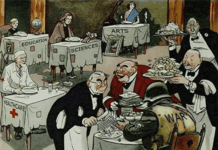






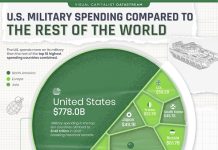


Military spending stimulates the economy but it does not re-distribute wealth. And that is why it appeals to reactionary politicians.
We see that in the UK at the moment. Keir Starmer’s government prefers to spend money on the war in the Ukraine rather than give it to the families of children in poverty. Pretending that the money does not exist is a familiar mantra.